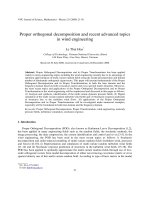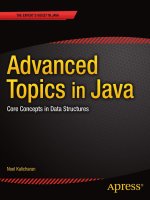advanced topics in information resources management. volume 1
Bạn đang xem bản rút gọn của tài liệu. Xem và tải ngay bản đầy đủ của tài liệu tại đây (3.62 MB, 399 trang )
Advanced
Topics in
Information
Resources
Management
Mehdi Khosrowpour
IDEA GROUP PUBLISHING
TEAMFLY
Team-Fly
®
Advanced Topics in
Information Resources
Management
Mehdi Khosrowpour
Information Resources Management Association, USA
Idea Group
Publishing
Information Science
Publishing
Hershey • London • Melbourne • Singapore • Beijing
Acquisition Editor: Mehdi Khosrowpour
Managing Editor: Jan Travers
Development Editor: Michele Rossi
Copy Editor: Beth Arneson
Typesetter: LeAnn Whitcomb
Cover Design: Tedi Wingard
Printed at: Integrated Book Technology
Published in the United States of America by
Idea Group Publishing
1331 E. Chocolate Avenue
Hershey PA 17033-1117
Tel: 717-533-8845
Fax: 717-533-8661
E-mail:
Web site:
and in the United Kingdom by
Idea Group Publishing
3 Henrietta Street
Covent Garden
London WC2E 8LU
Tel: 44 20 7240 0856
Fax: 44 20 7379 3313
Web site:
Copyright © 2002 by Idea Group Publishing. All rights reserved. No part of this book may be
reproduced in any form or by any means, electronic or mechanical, including photocopying, without
written permission from the publisher.
Library of Congress Cataloging in Publication Data
Khosrowpour, Mehdi, 1951-
Advanced topics in information resources management / Mehdi Khosrowpour
p. cm.
Includes bibliographical references and index.
ISBN 1-930708-44-0 (cloth)
1. Database management. 2. Information resources management. I. Title.
QA76.9.D3 .K4962 2002
005.74 dc21 2001059435
Advanced Topics in Information Resources Management is part of the Idea Group Publishing series
named Advanced Topics in Information Resources Management Series (ISSN 1537-9329)
eISBN 1-59140-030-9
British Cataloguing in Publication Data
A Cataloguing in Publication record for this book is available from the British Library.
NEW from Idea Group Publishing
Excellent additions to your library!
Receive the Idea Group Publishing catalog with descriptions of these books by calling,
toll free 1/800-345-4332
or visit the IGP Online Bookstore at: !
• Data Mining: A Heuristic Approach
Hussein Aly Abbass, Ruhul Amin Sarker and Charles S. Newton/1-930708-25-4
• Managing Information Technology in Small Business: Challenges and Solutions
Stephen Burgess/1-930708-35-1
• Managing Web Usage in the Workplace: A Social, Ethical and Legal Perspective
Murugan Anandarajan and Claire Simmers/1-930708-18-1
• Challenges of Information Technology Education in the 21st Century
Eli Cohen/1-930708-34-3
• Social Responsibility in the Information Age: Issues and Controversies
Gurpreet Dhillon/1-930708-11-4
• Database Integrity: Challenges and Solutions
Jorge H. Doorn and Laura Rivero/1-930708-38-6
• Managing Virtual Web Organizations in the 21st Century: Issues and Challenges
Ulrich Franke/1-930708-24-6
• Managing Business with Electronic Commerce: Issues and Trends
Aryya Gangopadhyay/1-930708-12-2
• Electronic Government: Design, Applications and Management
Åke Grönlund/1-930708-19-X
• Knowledge Media in Healthcare: Opportunities and Challenges
Rolf Grutter/1-930708-13-0
• Internet Management Issues: A Global Perspective
John D. Haynes/1-930708-21-1
• Enterprise Resource Planning: Global Opportunities and Challenges
Liaquat Hossain, Jon David Patrick and M. A. Rashid/1-930708-36-X
• The Design and Management of Effective Distance Learning Programs
Richard Discenza, Caroline Howard and Karen Schenk/1-930708-20-3
• Multirate Systems: Design and Applications
Gordana Jovanovic-Dolecek/1-930708-30-0
• Managing IT/Community Partnerships in the 21st Century
Jonathan Lazar/1-930708-33-5
• Multimedia Networking: Technology, Management and Applications
Syed Mahbubur Rahman/ 1-930708-14-9
• Cases on Worldwide E-Commerce: Theory in Action
Mahesh Raisinghani/1-930708-27-0
• Designing Instruction for Technology-Enhanced Learning
Patricia L. Rogers/1-930708-28-9
• Heuristic and Optimization for Knowledge Discovery
Ruhul Amin Sarker, Hussein Aly Abbass and Charles Newton/1-930708-26-2
• Distributed Multimedia Databases: Techniques and Applications
Timothy K. Shih/1-930708-29-7
• Neural Networks in Business: Techniques and Applications
Kate Smith and Jatinder Gupta/1-930708-31-9
• Managing the Human Side of Information Technology: Challenges and Solutions
Edward Szewczak and Coral Snodgrass/1-930708-32-7
• Cases on Global IT Applications and Management: Successes and Pitfalls
Felix B. Tan/1-930708-16-5
• Enterprise Networking: Multilayer Switching and Applications
Vasilis Theoharakis and Dimitrios Serpanos/1-930708-17-3
• Measuring the Value of Information Technology
Han T. M. van der Zee/1-930708-08-4
• Business to Business Electronic Commerce: Challenges and Solutions
Merrill Warkentin/1-930708-09-2
Advanced Topics in Information
Resources Management
Table of Contents
Preface i
Mehdi Khosrowpour, Information Resources Management
Association, USA
Chapter I
Knowledge Management and New Organization Forms:
A Framework for Business Model Innovation 1
Yogesh Malhotra, @Brint.com LLC, USA
Chapter II
Using a Metadata Framework To Improve Data
Resources Quality 20
Tor Guimaraes, Tennessee Technological University, USA
Youngohc Yoon, University of Maryland, Baltimore, USA
Peter Aiken, Defense Information Systems Agency, USA
Chapter III
Visualizing IT Enabled Business Process Change 35
Martijn R. Hoogeweegen, Erasmus University Rotterdam
and A.T. Kearney, The Netherlands
Chapter IV
Relating IS Infrastructure to Core Competencies
and Competitive Advantage 53
Terry Anthony Byrd, Auburn University, USA
Chapter V
Theoretical Justification for IT Infrastructure Investments 73
Timothy R. Kayworth, Baylor University, USA
Debabroto Chatterjee, Washington State University, USA
V. Sambamurthy, University of Maryland, USA
Chapter VI
Technology Acceptance and Performance: An
Investigation Into Requisite Knowledge 90
Thomas E. Marshall, Auburn University, USA
Terry Anthony Byrd, Auburn University, USA
Lorraine R. Gardiner, Auburn University, USA
R. Kelly Rainer Jr., Auburn University, USA
Chapter VII
Motivations and Perceptions Related to the Acceptance
of Convergent Media Delivered Through the
World Wide Web 116
Thomas F. Stafford, University of Memphis, USA
Marla Royne Stafford, University of Memphis, USA
Neal G. Shaw, University of Texas at Arlington, USA
Chapter VIII
Key Issues in IS Management in Norway:
An Empirical Study Based on Q Methodology 127
Petter Gottschalk, Norwegian School of Management, Norway
Chapter IX
Managing Strategic IT Investment Decisions From
IT Investment Intensity to Effectiveness 141
Tzu-Chuan Chou, University of Warwick, UK
Robert G. Dyson, University of Warwick, UK
Philip L. Powell, University of Bath, UK
Chapter X
Extending the Technology Acceptance Model Beyond
Its Country of Origin: A Cultural Test in Western Europe 158
Said S. Al-Gahtani, King Khalid University, Saudi Arabia
Chapter XI
The Collaborative Use of Information Technology:
End-User Participation and System Success 184
William J. Doll, University of Toledo, USA
Xiaodong Deng, Oakland University, USA
Chapter XII
User Satisfaction With EDI: An Empirical Investigation 204
Mary C. Jones, Mississippi State University, USA
Robert C. Beatty, Texas Christian University, USA
Chapter XIII
Corporate Intranet Infusion 223
Lauren B. Eder, Rider University, USA
Marvin E. Darter, Rider University, USA
Chapter XIV
Dynamics of Information in Disseminating Academic
Research in the New Media: A Case Study 239
James K. Ho, University of Illinois at Chicago, USA
Chapter XV
Assessing the Value of Information Technology
Investment to Firm Performance 257
Qing Hu, Florida Atlantic University, USA
Robert T. Plant, University of Miami, USA
Chapter XVI
Some Evidence on the Detection of Data Errors 279
Barbara D. Klein, University of Michigan, Dearborn, USA
Chapter XVII
An Analysis of Academic Research Productivity
of Information Systems Faculty 296
Qing Hu, Florida Atlantic University, USA
T. Grandon Gill, University of South Florida, USA
Chapter XVIII
Integrating Knowledge Process and System Design
for Naval Battle Groups 315
Mark E. Nissen, Naval Postgraduate School, USA
Elias Oxendine IV, Naval Postgraduate School, USA
Chapter XIX
A Case Study of Project Champion Departure
in Expert Systems Development 333
Janice C. Sipior, Villanova University, USA
Chapter XX
Organizational Commitment in the IS Workplace:
An Empirical Investigation of Its Antecedents and Implications 352
Qiang Tu, Rochester Institute of Technology, USA
Bhanu Raghunathan, University of Toledo, USA
T. S. Raghunathan, University of Toledo, USA
About the Authors 375
Index 385
Preface
viii
The field of information resources management is broad and encompasses many
facets of information technology research and practice as well as business and
organizational processes. Because information technology changes at an incredible
rate, it is essential for all who use, teach or research information management to have
access to the most current data and research and keep up with the emerging trends.
This publication is the first volume (Vol. I-1) of the new Series on “Advanced Topics
in Information Resources Management” that is aimed to provide a greater under-
standing of issues, challenges, trends, and technologies effecting the overall utilization
and management of information technology in modern organizations around the world.
The chapters in this book address the emerging issues in information resources
management and its application. Knowledge management, business process
change, achieving and maintaining competitive advantage with information technol-
ogy and systems are topics relevant to business people and academics. Additionally,
the chapters provide concrete ways for academics to broaden their research and
case study examples, which will enable business people to avoid the pitfalls discussed
in the book
Chapter 1 entitled, “Knowledge management and New Organization Forms: A
Framework for Business Model Innovation” by Yogesh Malhotra of @Brint.com
(USA) proposes a conceptualization in the form of a framework for developing
knowledge management systems for business model innovation. This framework
will facilitate the development of new business models that are better suited to the
new business environment, which is characterized by a dynamic, discontinuous and
radical pace of change. The chapter further discusses how the application of this
framework can facilitate development of new business models.
Chapter 2 entitled, “Using a Metadata Framework to Improve Data Re-
sources Quality” by Tor Guimaraes, Tennessee Technological University,
Youngohc Yoon of University of Maryland Baltimore County and Peter Aiken,
Defense Information Systems Agency (USA) presents a metadata framework
as a critical tool to ensure data quality. The model presented enables further
development of life cycle phase-specific data quality engineering methods. The
chapter expands the concept of applicable data quality dimensions and presents
data quality as a function of four distinct components: data value quality, data
representation quality, data model quality, and data architecture quality. The
chapter then discusses each of these components.
Chapter 3 entitled, “Visualizing IT Enabled Business Process Change (BPC)”
ix
by Martijn Hoogeweegen of Erasmus College (Netherlands) focuses on support-
ing BPC mangers in their search for information technology (IT) enabled
alternative process designs. The authors provide a literature review to formulate
a number of IT enabled NBPC guidelines. They then visualize these guidelines
in process charts. Finally, the chapter discusses a case study to illustrate the
applicability of these guidelines.
Chapter 4 entitled, “Relating IS Infrastructure to Core Competencies and
Competitive Advantage” by Terry A. Byrd of Auburn University (USA) presents
and describes a model that illustrates the possible connection between competitive
advantage and IT. Furthermore, the chapter shows how one major component of the
overall IT resources, the information systems infrastructure might yield sustained
competitive advantage for an organization. By showing that information systems
infrastructure flexibility acts as an enabler of the core competencies, the author
demonstrates the relationship to sustained competitive advantage.
Chapter 5 entitled, “Theoretical Justification for IT Infrastructure Investments”
by Timothy Kayworth of Baylor University, Debabroto Chatterjee of Washington
State University and V. Sambamurthy of University of Maryland (USA) proposes
a theoretical framework to justify the value creating potential of IT infrastructure
investments. The chapter presents a conceptual framework that describes the nature
of IT infrastructure and its related components. Next, the authors discuss the role of
IT infrastructure as a competitive weapon and identify three areas where IT may
create strategic value and discuss specific theories and research propositions to
guide further infrastructure research.
Chapter 6 entitled, “Technology Acceptance and Performance: In Investigation
into Requisite Knowledge” by Thomas Marshall, Terry Byrd, Lorraine Gardner and
R. Kelly Rainer of Auburn University (USA) investigates how knowledge bases
contribute to subjects’ attitudes and performance in the use of Computer Aided
Software Engineering (CASE) tool database design. The study discussed in the
chapter identified requisite knowledge bases and knowledge base interactions that
significantly impacted subjects’ attitudes and performance. Based on the findings,
the authors present alternatives that may help organizations increase the benefits of
technology use and promote positive attitudes towards technology innovation
acceptance and adoption.
Chapter 7 entitled, “Motivations and Perceptions Related to the Acceptance of
Convergent Media Delivered Through the World Wide Web” by Thomas Stafford
and Marla Royne Stafford of University of Memphis and Neal G. Shaw of University
of Texas-Arlington (USA) examines the well-understood technology adoption
precepts of the Technology Acceptance Model in conjunction with the media-use
motivations theories arising from the adaptations of the Uses and Gratifications
perspective, with special emphasis on the emerging effects of social gratifications for
Internet use.
Chapter 8 entitled, “Key Issues in IS Management in Norway: An Empirical Study
x
Based on Q Methodology” by Petter Gottschalk of the Norwegian School of
Management (Norway) provides an overview of research approaches to key issues
studies combined with key issue results from previous research. The paper
introduces a three-step procedure for key issues selection and the author adopts a
Q-sort analysis. The chapter presents results from the Q-sort survey and analysis.
The most important issue as reported by the study is improving the links between
information systems strategy and business strategy.
Chapter 9 entitled, “Managing Strategic IT Investment Decisions From IT
Investment Intensity To Effectiveness” by Tzu-Chuan Chou and Robert G. Dyson
of the University of Warwick and Phillip L. Powell of University of Bath (UK)
proposes an analytical model employing a number of constructs, namely: effective-
ness of decisions, interaction and involvement in decision formulation process,
accuracy of information and strategic considerations in the evaluation process,
accuracy of information and strategic considerations in the evaluation process, rarity
of decisions, and the degree of IT intensity of an investment in strategic investment
decisions. The results show that interaction, accuracy of information and strategic
considerations are the mediators in linking of IT investment intensity and effectiveness.
Chapter 10 entitled, “Extending the Technology Acceptance Model Beyond its
Country of Origin: A Cultural Test in Western Europe” by Said Al-Gahtani of King
Khalid University (Saudi Arabia) reports on a study that attempted to theoretically
and empirically test the applicability of the technology acceptance model (TAM) in
the culture of Western Europe. The chapter begins by discussing the background
of spreadsheets and the role they played in the diffusion computer technology and
into organizations and then presents the results of the study.
Chapter 11 entitled, “The Collaborative Use of Information Technology: End-
User Participation and Systems Success” by William J. Doll of the University of
Toledo and Xiaodon Deng of Oakland University (USA) presents a congruence
construct of participation that measures whether end users participate as much as
they would like to in key systems analysis decisions. The results indicate that user
participation is best achieved in collaborative applications. The findings of this
chapter will help managers and analysts make better decisions about how to focus
efforts to increase participation and whether end-users should participate as much
as they want to.
Chapter 12 entitled, “User Satisfaction with EDI: An Empirical Investigation” by
Mary Jones of Mississippi State University and Robert Betty of Texas Christian
University (USA) identifies results of a study undertaken to identify antecedents of
end-user satisfaction by surveying key end users of EDI from a variety of
organizations across the United States. The results of the study indicate that the
greater the perceived benefits of EDI, the grater the user satisfaction. A second
results shows that the more compatible EDI is with existing organizational practices
and systems, the more satisfied the users are with them.
Chapter 13 entitled, “Corporate Intranet Infusion” by Lauren Eder and Marvin
Darter of Rider University (USA) examines organizational, contextual and technical
variables that are associated with intranet infusion in the United States. The authors
TEAMFLY
Team-Fly
®
xi
analyzed six independent variables using an ordered probit analysis to explain the
likelihood of the occurrence for different levels of intranet infusion. The results
indicate that top management support, IT infrastructure and competition positively
influence high levels of intranet infusion. Organizational size is negatively associated
with levels of intranet infusion.
Chapter 14 entitled, “Dynamics of Information in Disseminating Academic
Research in the New Media: A Case Study” by James Ho of University of Illinois
at Chicago presents the history of a case in point with data recorded over a period
of fifteen months. The results of the case study indicate that the Internet in general
and the World Wide Web in specific will be a significant resource in bridging the gap
between practice and relevant research. The author reports on a successful
experience in an experiment to disseminate research results in the New Media. The
article concludes that if professors are willing to broaden their customer base, there
is an expanding network of practitioners to tap their expertise and provide feedback
for their academic research.
Chapter 15 entitled, “Assessing the Value of Information Technology Investment
to Firm Performance” by Qing Hu of Florida Atlantic University and Robert Plant
of the University of Miami (USA) argues that the causal relationship between IT
investment and firm performance an not be reliably established through concurrent
IT and performance data. The authors speculate that inferring the causality of IT
investments in the years preceding are significantly correlated with the performance
of the firm in subsequent years may not be the most accurate. Rather, they discuss
a model, which indicates that improved financial performance over consecutive
years may contribute to the increase of IT investment in subsequent years.
Chapter 16 entitled, “Some Evidence on the Detection of Data Errors” by Barbara
Klein of University of Michigan—Dearborn (USA) reports the results of a study
showing that municipal bond analysts detect data errors the results provide insights
into the conditions under which users in organizational settings detect data errors and
discusses guidelines for improving error detection. The results of the study indicate
the users of information systems can be successful in detecting errors.
Chapter 17 entitled, “An Analysis of Academic Research Productivity of
Information Systems Faculty” by Qing Hu of Florida Atlantic University and T.
Grandon Gill of University of South Florida (USA) discusses the results of a study
inquiring about faculty research productivity. The results show that while there are
only two significant factors contributing positively to research productivity: time
allocated to research and the existence of a doctoral program, many other factors
appear to adversely affect research productivity. The results also suggest that some
of the commonly held motivations for research such as tenure or academic rate have
no effect at all.
Chapter 18 entitled, “Integrating Knowledge Process and System Design for
Naval Battle Groups” by Mark Nissen and Elias Oxedine IV of the Naval
Postgraduate School (USA) integrates a framework for knowledge process and
system design that covers the gamut of design considerations from the enterprise
xii
process in the large, through alternative classes of knowledge in the middle and onto
specific systems in detail. Using the methodology suggested in the chapter, the reader
can see how to identify, select, compose and integrate the many component applications
and technologies required for effective knowledge system and process design.
Chapter 19 entitled, “A Case Study of Project Champion Departure in Expert
Systems Development” by Janice Sipior of Villanova University (USA) discusses an
expert systems project by examining the experiences of Cib-Geigy corporation with
an expert systems project which was impeded by the departure of the project
champion. When the driving force behind the project was transferred, the expert
systems project stalled. The chapter discusses the difficulties in maintaining
momentum for a project without a leader and presents suggestions for organizations
so that they can avoid the pitfalls encountered.
Chapter 20 entitled, “Organizational Commitment in the IS Workplace: An
Empirical Investigation of Its Antecedents and Implications” by Qiang Tu of
Rochester Institute of Technology and Bhanu Raghunathan and T.S. Raghunathan
of the University of Toledo (USA) attempts to fill a gap by empirically examining the
relationships among a set of organizational and psychological factors and the
organizational commitment of IS managers. The authors employed rigorous
statistical analysis using the method of LISREL path. The results indicate that these
variables are closely related to each other providing valuable insights for organiza-
tions to more effectively manage there IS human resources.
Information management in all its forms has revolutionized business, teaching and
learning throughout the world. The chapters in this book address the most current
topics in information management such as knowledge management, organizational
commitment, implementing expert systems and assessing the relevance and value of
IT to a variety of organizations. Academics and researchers will find the research
discussed an excellent starting point for discussions and springboard for their own
research. Practitioners and business people will find concrete advice on how to
assess IT’s use to their organization, how to most effectively use their human and
IT resources and how to avoid the problems encountered by the organizations
discussed in the above chapters. This book is a must read for all those interested in
or utilizing information management in all its forms.
Mehdi Khosrowpour
Information Resources Management Association
October, 2001
Knowledge Management and New Organization Forms 1
Chapter I
Knowledge Management and
New Organization Forms: A
Framework for Business
Model Innovation
Yogesh Malhotra
@Brint.com LLC, USA
Appeared in Information Resources Management Journal, Vol. 13, no. 1, 2000. Reprinted by permission.
The concept of knowledge management is not new in information systems
practice and research. However, radical changes in the business environment have
suggested limitations of the traditional information-processing view of knowledge
management. Specifically, it is being realized that the programmed nature of
heuristics underlying such systems may be inadequate for coping with the demands
imposed by the new business environments. New business environments are
characterized not only by rapid pace of change but also discontinuous nature of such
change. The new business environment, characterized by dynamically discontinu-
ous change, requires a reconceptualization of knowledge management as it has been
understood in information systems practice and research. One such conceptualization
is proposed in the form of a sense-making model of knowledge management for new
business environments. Application of this framework will facilitate business
model innovation necessary for sustainable competitive advantage in the new
business environment characterized by dynamic, discontinuous and radical
pace of change.
“People bring imagination and life to a transforming technology.”–
Business Week, The Internet Age (Special Report), October 4, 1999,
p. 108.
2 Malhotra
The traditional organizational business model, driven by prespecified plans
and goals, aimed to ensure optimization and efficiencies based primarily on building
consensus, convergence and compliance. Organizational information systems–as
well as related performance and control systems–were modeled on the same
paradigm to enable convergence by ensuring adherence to organizational routines
built into formal and informal information systems. Such routinization of organiza-
tional goals for realizing increased efficiencies was suitable for the era marked by
a relatively stable and predictable business environment. However, this model is
increasingly inadequate in the e-business era, which is often characterized by an
increasing pace of radical and unforeseen change in the business environment
(Arthur, 1996; Barabba, 1998; Malhotra, 1998b; Kalakota & Robinson, 1999;
Nadler et al., 1995).
The new era of dynamic and discontinuous change requires continual reassess-
ment of organizational routines to ensure that organizational decision-making
processes, as well as underlying assumptions, keep pace with the dynamically
changing business environment. This issue poses increasing challenge as “best
services” of yesterday–turn into “worst practices” and core competencies turn into
core rigidities. The changing business environment, characterized by dynamically
discontinuous change, requires a reconceptualization of knowledge management
systems as they have been understood in information systems practice and research.
One such conceptualization is proposed in this article in the form of a framework
for developing organizational knowledge management systems for business model
innovation. It is anticipated that application of this framework will facilitate
development of new business models that are better suited to the new business
environment characterized by dynamic, discontinuous and radical pace of change.
The popular technology-centric interpretations of knowledge management
that have been prevalent in most of the information technology research and trade
press are reviewed in the next section. The problems and caveats inherent in such
interpretations are then discussed. The subsequent section discusses the demands
imposed by the new business environments that require rethinking such
conceptualizations of knowledge management and related information technology
based systems. One conceptualization for overcoming the problems of prevalent
interpretations and related assumptions is then discussed along with a framework
for developing new organization forms and innovative business models. Subsequent
discussion explains how the application of this framework can facilitate development of
new business models that are better suited to the dynamic, discontinuous and radical pace
of change characterizing the new business environment.
KNOWLEDGE MANAGEMENT: THE
INFORMATION-PROCESSING PARADIGM
The information-processing view of knowledge management has been preva-
lent in information systems practice and research over the last few decades. This
Knowledge Management and New Organization Forms 3
perspective originated in the era when the business environment was less
vacillating, the products and services and the corresponding core competencies
had a long multiyear shelf life, and the organizational and industry boundaries
were clearly demarcated over the foreseeable future. The relatively structured
and predictable business and competitive environment rewarded firms’ focus on
economies of scale. Such economies of scale were often based on high level of
efficiencies of scale in absence of impending threat of rapid obsolescence of
product and service definitions as well as demarcations of existing organiza-
tional and industry boundaries.
The evolution of the information-processing paradigm over the last four
decades to build intelligence and manage change in business functions and pro-
cesses has generally progressed over three phases:
1. Automation: increased efficiency of operations;
2. Rationalization of procedures: streamlining of procedures and eliminating
obvious bottlenecks that are revealed by automation for enhanced efficiency
of operations; and
3. Reengineering: radical redesign of business processes that depends upon
information-technology-intensive radical redesign of work flows and
work processes.
The information-processing paradigm has been prevalent over all three phases,
which have been characterized by technology-intensive, optimization-driven, effi-
ciency-seeking organizational change (Malhotra, 1999b, 1999c, in press). The
deployment of information technologies in all three phases was based on a relatively
predictable view of products and services as well as contributory organizational and
industrial structures.
Despite increase in risks and corresponding returns relevant to the three kinds
of information-technology-enabled organizational change, there was little, if any,
emphasis on business model innovation–rethinking the business–as illustrated in
Figure 1. Based on the consensus and convergence-oriented view of information
systems, the information-processing view of knowledge management is often
Figure 1: Information-processing paradigm: Old world of business
Reengineering
Automation
Rationalization
Risk
Return
4 Malhotra
characterized by benchmarking and transfer of best practices (Allee, 1997; O’Dell
& Grayson, 1998). The key assumptions of the information-processing view are
often based on the premise of the generalizability of issues across temporal and
contextual frames of diverse organizations.
Such interpretations have often assumed that adaptive functioning of the
organization can be based on explicit knowledge of individuals archived in
corporate databases and technology-based knowledge repositories (Applegate,
Cash & Mills, 1988, p. 44; italics added for emphasis):
Information systems will maintain the corporate history, experience and
expertise that long-term employees now hold. The information systems
themselves–not the people–can become the stable structure of the
organization. People will be free to come and go, but the value of their
experience will be incorporated in the systems that help them and their
successors run the business.
The information-processing view, evident in scores of definitions of knowl-
edge management in the trade press, has considered organizational memory of the
past as a reliable predictor of the dynamically and discontinuously changing
business environment. Most such interpretations have also made simplistic assump-
tions about storing past knowledge of individuals in the form of routinized rules-of-
thumb and best practices for guiding future action. A representative compilation of
such interpretations of knowledge management is listed in Table 1.
Based primarily upon a static and “syntactic” notion of knowledge, such
representations have often specified the minutiae of machinery while disregarding
how people in organizations actually go about acquiring, sharing and creating new
knowledge (Davenport, 1994). By considering the meaning of knowledge as
“unproblematic, predefined, and prepackaged” (Boland, 1987), such interpreta-
tions of knowledge management have ignored the human dimension of organiza-
tional knowledge creation. Prepackaged or taken-for-granted interpretation of
knowledge works against the generation of multiple and contradictory viewpoints
that are necessary for meeting the challenge posed by wicked environments
characterized by radical and discontinuous change: this may even hamper the firm’s
learning and adaptive capabilities (Gill, 1995). A key motivation of this article is to
address the critical processes of creation of new knowledge and renewal of existing
knowledge and to suggest a framework that can provide the philosophical and
pragmatic bases for better representation and design of organizational knowl-
edge management systems.
Philosophical Bases of the Information-Processing Model
Churchman (1971) had interpreted the viewpoints of philosophers Leibnitz,
Locke, Kant, Hagel and Singer in the context of designing information systems.
Mason and Mitroff (1973) had made preliminary suggestions for designing infor-
mation systems based on Churchman’s framework. A review of Churchman’s
inquiring systems, in context of the extant thinking on knowledge management,
Knowledge Management and New Organization Forms 5
Table 1: Knowledge management: The information-processing paradigm
The process of collecting, organizing, classifying and disseminating information throughout an
organization, so as to make it purposeful to those who need it. (Midrange Systems: Albert, 1998)
Policies, procedures and technologies employed for operating a continuously updated linked pair
of networked databases. (Computerworld: Anthes, 1991)
Partly as a reaction to downsizing, some organizations are now trying to use technology to capture
the knowledge residing in the minds of their employees so it can be easily shared across the
enterprise. Knowledge management aims to capture the knowledge that employees really need
in a central repository and filter out the surplus. (Forbes: Bair, 1997)
Ensuring a complete development and implementation environment designed for use in a specific
function requiring expert systems support. (International Journal of Bank Marketing: Chorafas,
1987)
Knowledge management IT concerns organizing and analyzing information in a company’s
computer databases so this knowledge can be readily shared throughout a company, instead of
languishing in the department where it was created, inaccessible to other employees. (CPA
Journal, 1998)
Identification of categories of knowledge needed to support the overall business strategy,
assessment of current state of the firm’s knowledge and transformation of the current knowledge
base into a new and more powerful knowledge base by filling knowledge gaps. (Computerworld:
Gopal & Gagnon, 1995)
Combining indexing, searching, and push technology to help companies organize data stored in
multiple sources and deliver only relevant information to users. (Information Week: Hibbard,
1997)
Knowledge management in general tries to organize and make available important know-how,
wherever and whenever it’s needed. This includes processes, procedures, patents, reference
works, formulas, “best practices,” forecasts and fixes. Technologically, intranets, groupware,
data warehouses, networks, bulletin boards, and videoconferencing are key tools for storing and
distributing this intelligence. (Computerworld: Maglitta, 1996)
Mapping knowledge and information resources both on-line and off-line; training, guiding and
equipping users with knowledge access tools; monitoring outside news and information.
(Computerworld: Maglitta, 1995)
Knowledge management incorporates intelligent searching, categorization and accessing of data
from disparate databases, e-mail and files. (Computer Reseller News: Willett & Copeland, 1998)
Understanding the relationships of data; identifying and documenting rules for managing data;
and assuring that data are accurate and maintain integrity. (Software Magazine: Strapko, 1990)
Facilitation of autonomous coordinability of decentralized subsystems that can state and adapt
to their own objectives. (Human Systems Management; Zeleny, 1987)
underscores the limitations of the dominant model of inquiring systems being used
by today’s organizations. Most technology-based conceptualizations of knowledge
management have been primarily based upon heuristics–embedded in procedure
manuals, mathematical models or programmed logic–that, arguably, capture the
preferred solutions to the given repertoire of organizations’ problems.
Following Churchman, such systems are best suited for:
(a) well-structured problem situations for which there exists strong consensual
position on the nature of the problem situation, and
(b) well-structured problems for which there exists an analytic formulation with
a solution.
6 Malhotra
Type (a) systems are classified as Lockean inquiry systems and type (b) systems are
classified as Leibnitzian inquiry systems. Leibnitzian systems are closed systems
without access to the external environment: they operate based on given axioms and
may fall into competency traps based on diminishing returns from the “tried and
tested” heuristics embedded in the inquiry processes. In contrast, the Lockean
systems are based on consensual agreement and aim to reduce equivocality
embedded in the diverse interpretations of the worldview. However, in absence of
a consensus, these inquiry systems also tend to fail.
The convergent and consensus building emphasis of these two kinds of inquiry
systems is suited for stable and predictable organizational environments. However,
wicked environment imposes the need for variety and complexity of the interpreta-
tions that are necessary for deciphering the multiple world-views of the uncertain
and unpredictable future.
BEYOND EXISTING MYTHS ABOUT
KNOWLEDGE MANAGEMENT
The information-processing view of knowledge management has propagated
some dangerous myths about knowledge management. Simplistic representations
of knowledge management that often appear in popular press may often result in
misdirected investments and system implementations that never yield expected
returns (Strassmann, 1997, 1999).
Given the impending backlash against such simplistic representations of
knowledge management (Garner, 1999), it is critical to analyze the myths under-
lying the “successful” representations of knowledge management that worked in a
bygone era. There are three dominant myths based on the information-processing
logic that are characteristic of most popular knowledge management interpretations
(Hildebrand, 1999–Interview of the author with CIO Enterprise magazine).
Myth 1: Knowledge management technologies can deliver the right infor-
mation to the right person at the right time. This idea applies to an outdated
business model. Information systems in the old industrial model mirror the notion
that businesses will change incrementally in an inherently stable market, and
executives can foresee change by examining the past. The new business model of
the Information Age, however, is marked by fundamental, not incremental, change.
Businesses can’t plan long-term; instead, they must shift to a more flexible
“anticipation-of-surprise” model. Thus, it’s impossible to build a system that
predicts who the right person at the right time even is, let alone what constitutes the
right information.
Myth 2: Knowledge management technologies can store human intelli-
gence and experience. Technologies such as databases and groupware applications
store bits and pixels of data, but they can’t store the rich schemas that people possess
for making sense of data bits. Moreover, information is context-sensitive. The same
assemblage of data can evoke different responses from different people. Even the
Knowledge Management and New Organization Forms 7
same assemblage of data when reviewed by the same person at a different time or
in a different context could evoke differing response in terms of decision making and
action. Hence, storing a static representation of the explicit representation of a
person’s knowledge–assuming one has the willingness and the ability to part with
it–is not tantamount to storing human intelligence and experience.
Myth 3: Knowledge management technologies can distribute human intel-
ligence. Again, this assumes that companies can predict the right information to
distribute and the right people to distribute it to. And bypassing the distribution issue
by compiling a central repository of data for people to access doesn’t solve the
problem either. The fact of information archived in a database doesn’t ensure that
people will necessarily see or use the information. Most of our knowledge manage-
ment technology concentrates on efficiency and creating a consensus-oriented
view. The data archived in technological “knowledge repositories” is rational, static
and without context and such systems do not account for renewal of existing
knowledge and creation of new knowledge.
The above observations seem consistent with observations by industry
experts such as John Seely-Brown (1997), who observed that: “In the last 20
years, U.S. industry has invested more than $1 trillion in technology, but has
realized little improvement in the efficiency of its knowledge workers and
virtually none in their effectiveness.”
Given the dangerous perception about knowledge management as seamlessly
entwined with technology, “its true critical success factors will be lost in the
pleasing hum of servers, software and pipes” (Hildebrand, 1999). Hence, it is
critical to focus the attention of those interested in knowledge management on the
critical success factors that are necessary for business model innovation.
To distinguish from the information-processing paradigm of knowledge
management discussed earlier, the proposed paradigm will be denoted as the sense-
making paradigm of knowledge management. This proposed framework is based on
Churchman’s (1971, p. 10) explicit recognition that “knowledge resides in the user
and not in the collection of information … it is how the user reacts to a collection
of information that matters.”
Churchman’s emphasis on the human nature of knowledge creation seems
more pertinent today than it seemed 25 years ago given the increasing prevalence
of “wicked” environment characterized by discontinuous change (Nadler & Shaw,
1995) and “wide range of potential surprise” (Landau & Stout, 1979). Such an
environment defeats the traditional organizational response of predicting and
reacting based on preprogrammed heuristics. Instead, it demands more anticipatory
responses from the organization members who need to carry out the mandate of a
faster cycle of knowledge creation and action based on the new knowledge (Nadler
& Shaw, 1995).
Philosophical Bases of the Proposed Model
Churchman had proposed two alternative kinds of inquiry systems that are
particularly suited for multiplicity of worldviews needed for radically changing
8 Malhotra
environments: Kantian inquiry systems and Hegelian inquiry systems. Kantian
inquiry systems attempt to give multiple explicit views of complementary nature and
are best suited for moderate, ill-structured problems. However, given that there is
no explicit opposition to the multiple views, these systems may also be afflicted by
competency traps characterized by plurality of complementary solutions. In con-
trast, Hegelian inquiry systems are based on a synthesis of multiple completely
antithetical representations that are characterized by intense conflict because of the
contrary underlying assumptions. Knowledge management systems based upon the
Hegelian inquiry systems would facilitate multiple and contradictory interpreta-
tions of the focal information. This process would ensure that the “best practices”
are subject to continual reexamination and modification given the dynamically
changing business environment.
Given the increasingly wicked nature of business environment, there seems to
be an imperative need for consideration of the Kantian and Hegelian inquiring
systems that can provide the multiple, diverse, and contradictory interpretations.
Such systems, by generating multiple semantic views of the future characterized by
increasingly rapid pace of discontinuous change, would facilitate anticipation of
surprise (Kerr, 1995) over prediction. They are most suited for dialectical inquiry
based on dialogue: “meaning passing or moving through a free flow of meaning
between people” (Bohm cited in Senge, 1990). The underpinning discussion asserts
the critical role of the individual and social processes that underlie the creation of
meaning (Strombach, 1986, p. 77), without which dialectical inquiry would not be
possible. Therein lies the crucial sense-making role of humans in facilitating
knowledge creation in inquiring organizations.
Continuously challenging the current “company way,” such systems provide
the basis for “creative abrasion” (Eisenhardt, Kahwajy & Bourgeois, 1997; Leonard,
1997) that is necessary for promoting radical analysis for business model innova-
tion. In essence, knowledge management systems based on the proposed model
prevent the core capabilities of yesterday from becoming core rigidities of tomor-
row (Leonard-Barton, 1995). It is critical to look at knowledge management beyond
its representation as “know what you know and profit from it” (Fryer, 1999) to
“obsolete what you know before others obsolete it and profit by creating the
challenges and opportunities others haven’t even thought about” (Malhotra, 1999d).
This is the new paradigm of knowledge management for radical innovation required
for sustainable competitive advantage in a business environment characterized by
radical and discontinuous pace of change.
KNOWLEDGE MANAGEMENT FOR BUSINESS
MODEL INNOVATION: FROM BEST
PRACTICES TO PARADIGM SHIFTS
As discussed above, in contrast to the information-processing model based on
deterministic assumptions about predictability of the future, the sense-making
TEAMFLY
Team-Fly
®
Knowledge Management and New Organization Forms 9
model is more conducive for sustaining competitive advantage in the “world of
re-everything” (Arthur, 1996). Without such radical innovation, one wouldn’t
have observed the paradigm shifts in core value propositions served by new
business models.
Such rethinking of the nature of the business and the nature of the organization
itself characterizes paradigm shifts that are the hallmark of business model innova-
tion. Such paradigm shifts will be attributable for about 70% of the previously
unforeseen competitive players that many established organizations will encounter
in their future (Hamel, 1997).
Examples of such new business models include Amazon.com and eToys,
relatively new entrants that are threatening traditional business models embodied in
organizations such as Barnes & Noble and Toys “R” Us. Such business model
innovations represent “paradigm shifts” that characterize not transformation at the
level of business processes and process work flows, but radical rethinking of the
business as well as the dividing lines between organizations and industries.
Such paradigm shifts are critical for overcoming managers’ “blindness to
developments occurring outside their core [operations and business segments]” and
tapping the opportunities in “white spaces” that lie between existing markets and
operations (Moore, 1998).
The notions of “best practices” and “benchmarking” relate to the model of
organizational controls that are “built, a priori, on the principal of closure” (Landau
& Stout, 1979, p. 150; Stout, 1980) to seek compliance to, and convergence of, the
organizational decision-making processes (Flamholtz, Das & Tsui, 1985). How-
ever, the decision rules embedded in “best practices” assume the character of
predictive “proclamations” which draw their legitimacy from the vested authority,
not because they provide adequate solutions (Hamel & Prahalad, 1994, p. 145).
Challenges to such decision rules tend to be perceived as challenges to the authority
embedded in “best practices” (Landau, 1973).
Hence, such “best practices” that ensure conformity by ensuring task defini-
tion, measurement and control also inhibit creativity and initiative (Bartlett &
Figure 2: From best practices to paradigm shifts
Reengineering
Rationalization
Automation
Reengineering IT-intensive radical redesign
Rationalization Streamlining bottlenecks in 2orkflows
Autoamton Re placing humans with machines
Paradigm Shifts
“Re-Everything”
10 Malhotra
Ghoshal, 1995; Ghoshal & Bartlett 1995). The system that is structured as a “core
capability” suited to a relatively static business environment turns into a “core
rigidity” in a discontinuously changing business environment. Despite the transient
efficacy of “best practices,” the cycle of doing “more of the same” tends to result
in locked-in behavior patterns that eventually sacrifice organizational perfor-
mance at the altar of the organizational “death spiral” (Nadler & Shaw 1995, p.
12-13). In the e-business era, which is increasingly characterized by faster cycle
time, greater competition, and lesser stability, certainty and predictability, any
kind of consensus cannot keep pace with the dynamically discontinuous changes
in the business environment (Bartlett & Ghoshal 1995; Drucker, 1994; Ghoshal
& Bartlett, 1996).
With its key emphasis on the obedience of rules embedded in “best
practices” and “benchmarks” at the cost of correction of errors (Landau & Stout,
1979), the information-processing model of knowledge management limits
creation of new organizational knowledge and impedes renewal of existing
organizational knowledge.
Most of the innovative business models such as Cisco and Amazon.com didn’t
devolve from the best practices or benchmarks of the organizations of yesterday that
they displaced, but from radical re-conceptualization of the nature of the business.
These paradigm shifts are also increasingly expected to challenge the traditional
concepts of organization and industry (Mathur & Kenyon, 1997) with the emer-
gence of business ecosystems (Moore, 1998), virtual communities of practice
(Hagel & Armstrong, 1997) and infomediaries (Hagel & Singer, 1999).
HUMAN ASPECTS OF KNOWLEDGE
CREATION AND KNOWLEDGE RENEWAL
Knowledge management technologies based upon the information-processing
model are limited in the capabilities for creation of new knowledge or renewal of
Figure 3: Paradigm shifts: New world of business
Risk
Ret urn
Paradigm Shifts
70% Risks
70% Returns
Reengineering
Automation
Rationalization
Knowledge Management and New Organization Forms 11
existing knowledge. No doubt, such technologies provide the optimization-driven,
efficiency-seeking behavior needed for high performance and success in a business
environment characterized by a predictable and incremental pace of change.
Examples of technologies that are based on a high level of integration such as ERP
technologies represent knowledge management technologies based upon the infor-
mation-processing model. However, given a radical and discontinuously changing
business environment, these technologies fall short of sensing changes that they
haven’t been preprogrammed to sense and accordingly are unable to modify the logic
underlying their behavior.
Until information systems embedded in technology become capable of antici-
pating change and changing their basic assumptions (heuristics) accordingly, we
would need to rely upon humans for performing the increasingly relevant function
of self-adaptation and knowledge creation. However, the vision of information
systems that can autonomously revamp their past history based upon their anticipa-
tion of future change is yet far from reality (Wolpert, 1996). Given the constraints
inherent in the extant mechanistic (programmed) nature of technology, the human
element assumes greater relevance for maintaining currency of the programmed
heuristics (programmed routines based upon previous assumptions). Therefore, the
human function of ensuring the reality check–by means of repetitive questioning,
interpretation and revision of the assumptions underlying the information system–
assumes an increasingly important role in the era marked by discontinuous change.
The human aspects of knowledge creation and knowledge renewal that are
difficult–if not impossibl–to replace by knowledge management technologies are
listed below.
• Imagination and creativity latent in human minds
• Untapped tacit dimensions of knowledge creation
• Subjective and meaning-making bases of knowledge creation
• Constructive aspects of knowledge creation and renewal
The following discussion explains these issues in greater detail and suggests how
they can help overcome the limitations of the information-processing model of
knowledge management.
Imagination and Creativity Latent in Human Minds: Knowledge manage-
ment solutions characterized by memorization of “best practices” may tend to define
the assumptions that are embedded not only in information databases, but also in the
organization’s strategy, reward systems and resource allocation systems. The
hardwiring of such assumptions in organizational knowledge bases may lead to
perceptual insensitivity (Hedberg, Nystrom & Starbuck, 1976) of the organization
to the changing environment. Institutionalization of “best practices” by embedding
them in information technology might facilitate efficient handling of routine,
“linear,” and predictable situations during stable or incrementally changing envi-
ronments. However, when this change is discontinuous, there is a persistent need for
continuous renewal of the basic premises underlying the “best practices” stored in
organizational knowledge bases. The information-processing model of knowledge
management is devoid of such capabilities which are essential for continuous
12 Malhotra
learning and unlearning mandated by radical and discontinuous change. A more
proactive involvement of the human imagination and creativity (March, 1971) is
needed to facilitate greater internal diversity (of the organization) that can match the
variety and complexity of the wicked environment.
Untapped Tacit Dimensions of Knowledge Creation: The information-
processing model of knowledge management ignores tacit knowledge deeply rooted
in the individual’s action and experience, ideals, values, or emotions (Nonaka &
Takeuchi, 1995). Although tacit knowledge lies at the very basis of organizational
knowledge creation, its nature renders it highly personal and hard to formalize and
to communicate. Nonaka and Takeuchi (1995) have suggested that knowledge is
created through four different modes: (1) socialization, which involves conversion
from tacit knowledge to tacit knowledge, (2) externalization, which involves
conversion from tacit knowledge to explicit knowledge, (3) combination, which
involves conversion from explicit knowledge to explicit knowledge, and (4)
internalization, which involves conversion from explicit knowledge to tacit knowl-
edge. The dominant model of inquiring systems is limited in its ability to foster
shared experience necessary for relating to others’ thinking processes, thus limiting
its utility in socialization. It may, by virtue of its ability to convert tacit knowledge
into explicit forms such as metaphors, analogies and models, have some utility in
externalization. This utility is however restricted by its ability to support dialogue
or collective reflection. The current model of inquiring systems, apparently, may
have a greater role in combination, involving combining different bodies of explicit
knowledge, and internalization, which involves knowledge transfer through verbal-
izing or diagramming into documents, manuals and stories. A more explicit
recognition of tacit knowledge and related human aspects, such as ideals,
values, or emotions, is necessary for developing a richer conceptualization of
knowledge management.
Subjective and Meaning-Making Bases of Knowledge Creation: Wicked
environments call for interpretation of new events and ongoing reinterpretation and
reanalysis of assumptions underlying extant practices. However, the information-
processing model of knowledge management largely ignores the important con-
struct of meaning (Boland, 1987) as well as its transient and ambiguous nature.
“Prepackaged” or “taken-for-granted” interpretation of knowledge residing in the
organizational memories works against generation of multiple and contradictory
viewpoints necessary for ill-structured environments. Simplification of contextual
information for storage in IT-enabled repositories works against the retention of the
complexity of multiple viewpoints. Institutionalization of definitions and interpre-
tations of events and issues works against the exchanging and sharing of diverse
perspectives. To some extent the current knowledge management technologies,
based on their ability to communicate metaphors, analogies and stories by using
multimedia technologies, may offer some representation and communication of
meaning. However, a more human-centric view of knowledge creation is necessary
to enable the interpretative, subjective and meaning-making nature of knowledge
creation. Investing in multiple and diverse interpretations is expected to enable









